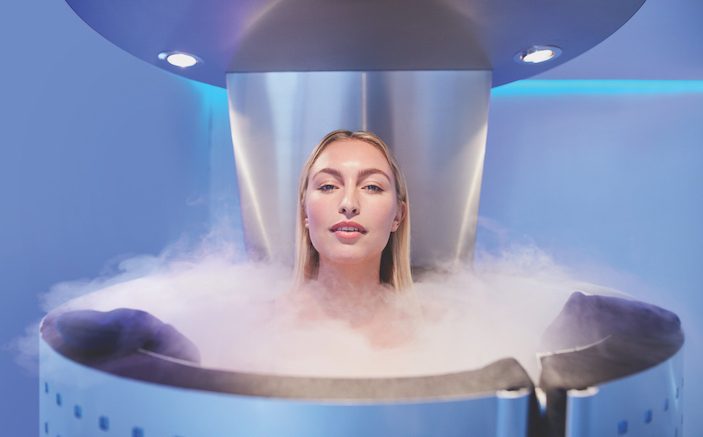Humans naturally avoid extremely cold temperatures, but entrepreneurs promising medical benefits from cold exposure have some patients paying for the experience in recent years. The winds of trendy changes have brought a new cold front into town. Whole Body Cryotherapy (“WBC”) ‘cryo-spas’ are appearing in strip malls next to tanning booths, claiming everything from “improving circulation” to “halting aging” with little scientific data to support their claims. Impact Cryotherapy, the leading manufacturer in the U.S., has more than 360 units in 40 states and seven foreign countries, including those serving 10 pro teams and six colleges.
Whole body cryotherapy involves entering an enclosed space filled with liquid nitrogen and being surrounded by vapors that range in temperature from minus 200 to minus 300 degrees F. Most sessions last two to four minutes and cost $40 to $100 per session. Clients are asked to wear protective equipment such as ear muffs, masks, gloves, slippers, socks, and undergarments. While there are evidence-based benefits for cryotherapy, such as analgesia and local anesthesia, these evidence-based local uses cannot be extrapolated to whole body applications. There are no RCTs for use of WBC for other conditions it purports to treat. The few studies that do exist have weak methodology performed by investigators with a financial interest in the product.
A September 2015 Cochrane Review on WBC concluded “There is insufficient evidence to determine whether whole-body cryotherapy reduces self-reported muscle soreness, or improves subjective recovery after exercise compared with passive rest or no WBC in physically active young adult males.” This Review also noted that the “lack of evidence on adverse events is important given that the exposure to extreme temperature presents a potential hazard.”
Governmental oversight of WBC is also lacking. The FDA has stated based on the marketing for cryotherapy “Consumers may incorrectly believe that the FDA has cleared or approved WBC devices as safe and effective to treat medical conditions.” It has not.
In fact, cryotherapy can be dangerous. Exposing the whole body to sub-freezing temperatures results in vasoconstriction of superficial vessels to preserve body heat. There is a sympathetic surge as a body responds to the challenge of maintaining temperature homeostasis to protect internal organs from damage. These protective physiologic responses can lead to arrhythmias, heart attacks, hypothermic shock, and even death. Direct exposure to liquid nitrogen may cause frostbite or other skin injuries. There is also a risk of asphyxiation as rapid evaporation of liquid nitrogen into nitrogen gas can suddenly reduce the partial pressure of oxygen in the air.
Thus far, there has been one reported case of death due to use of WBC, which occurred in October 2015 when an employee of a Nevada Cryo-center used the chamber alone and unsupervised after hours. Autopsy reports show that she died very rapidly.
What’s an EM doc to do?
If a patient comes in with a skin injury, it is important to know the duration of contact with the freezing agent and what type (gas or liquid nitrogen) to determine the likely extent of the injury. Wearing damp clothing in the chamber and exposure to the super-cooled gas can lead to common frostbite. If there is any kind of machine malfunction causing liquid nitrogen to be splashed onto the patient, burns may be severe. Gentle re-warming is indicated if the skin is intact. The Parkland formula for burns can be applied, and patients with large and severe frost burns should be stabilized and transferred to a burn center.
If a patient comes in unconscious after WBC, the most likely etiologies are asphyxia, arrhythmia, and cardiac arrest. Addressing the ABCs (and CABs, of course) along with high flow oxygen is the initial recommended treatment for most patients. A patient with return of spontaneous circulation without return of neurologic function can be considered for hyperbaric oxygen therapy in consultation with a specialist if asphyxia is thought to be the etiology of collapse.
The risks of WBC are known, and the benefits are unproven. I suggest using an old-fashioned ice pack for sore muscles and with all the money you saved, buying yourself something cool.




1 Comment
Where is your evidence that WBC “can lead to arrhythmias, heart attacks, hypothermic shock, and even death”? You purport yourself as some self-proclaimed expert on cryotherapy, and make a number of unfounded claims related to it’s physiological effects on the body. However, you only seem to be concerned with the negative effects because it suits your narrative.
Poorly done.